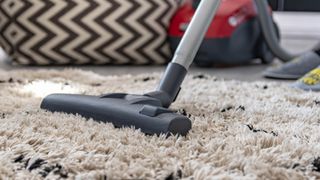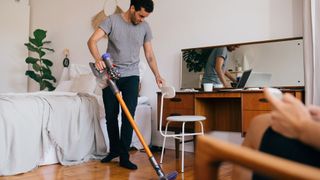How to vacuum
Here’s how to vacuum like a pro

Think you know how to vacuum? Think again. It’s not as simple as just plugging it in (if you have a corded model) and switching it on. If you’re not vacuuming correctly then you may as well not bother, which wouldn't be good for anyone (or anything) in your household.
Whether you have one of the best vacuum cleaners around or you’ve had the same trusty model for a few years now, we’ll be sharing tips and tricks for creating your cleanest floors yet, while also maintaining your vacuum for the best performance.
Vacuuming is essential if you want to keep your flooring looking clean but it’s also important for reducing allergens like dust and pet dander from building up in your home. A lot of what a vacuum does is remove dust particles that we can’t even see and keeping on top of these particles will also help keep your carpets in the best condition.
Some people like to vacuum when it’s really necessary - so when your flooring has visible food crumbs or dirt that’s been walked in through the house - but establishing a vacuuming routine is one of the only ways to make sure skin cells that we naturally shed, don’t sit on your carpet for too long.
Vacuuming frequently might sound like more hassle but it’ll actually make cleaning up easier as there won’t be as much embedded dust in your carpets.
- Save time and effort with the best robot vacuums
- Perfect espressos with the best coffee makers around
- Clean up with one of the best cordless vacuums
If you want to make sure your floors are really clean you’ll need to start with preparing the vacuum itself - and whether you have a stick model or a bagged vacuum, making sure the dust bin/ bag is empty should be your first task.
Cleaning the brushroll by removing any hair or debris that’s wrapped around it, will also be important before you start vacuuming - especially if you have a pet. There are specialist tools, such as a Pikk-it which you can buy in the UK on Amazon for £7.99 and they are designed to cut through hair and pull it away from the brushroll, or you can use scissors too if there’s a large amount of hair and you can't get hold of a specialist tool.
Get daily insight, inspiration and deals in your inbox
Get the hottest deals available in your inbox plus news, reviews, opinion, analysis and more from the TechRadar team.
If you’re cleaning a room completely, it’s always best to dust surfaces before you switch the vacuum on because dust will later settle on the floor. Once you’ve finished dusting, it’s time to start vacuuming.
The edges of rooms are often areas that get neglected and if you want to up your vacuum routine, the corners of your rooms are a good place to start. Take your vacuum’s crevice tool and work your way around the room reaching right into the edges of the carpet where the flooring meets the baseboards. Doing this will reach anywhere that your vacuum head won’t be able to get to and it’ll prevent that murky shading you often get on carpets over time.

You can also use the crevice tool to reach down the sides of your sofa, getting in between the cushions where crumbs and dust tend to settle. Once you’re all done with the crevice tool, switch back to your normal vacuum and start on one side of the room by vacuuming in slow back and forth motions. This might sound pretty obvious but it’s very tempting to just swipe one part of the carpet once and then head off to the next part without going over the same patch a few times.
It’s well worth slowing down while you vacuum because carpet strands, even though they’re small, they are, of course, three-dimensional and that means that dirt can stick to all sides of the strands. Merely vacuuming over the strands once is unlikely to pick up dust from all angles.
After you’ve worked your way from one side of the room to the other, vacuum again in the opposite direction. Even though the floor might appear clean because larger bits of dust have been sucked up, this second vacuum will help to suck up smaller particles of dust that the eye won’t see.
If you have both hard floors and carpets in your home, make sure you use the height adjustment on your vacuum so that the cleaning head can get as close to the floor as possible and make sure no dirt is left behind.
Once you’re finished vacuuming wipe down the vacuum itself to keep it nice and clean and empty the dust bin/ bag (it’s best to do this outside so that the dust doesn’t settle on your clean floors).
- Save today on the cheapest robot vacuums
Sophie writes about all things appliance-related and is currently the Home Editor at TechRadar's sister site, Top Ten Reviews. When she's not testing coffee machines and appliances, Sophie is thinking of eating delicious food, and asking people what they're having for dinner.

